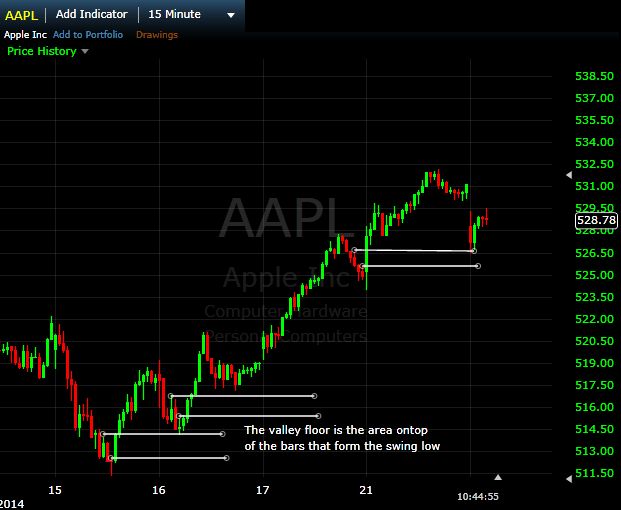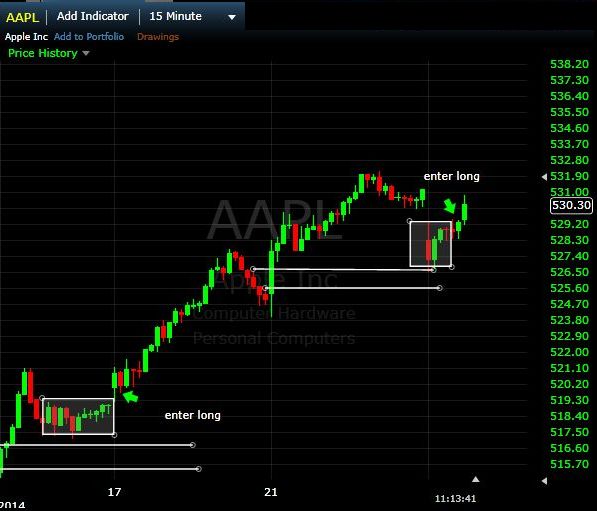The Valley Floor Trading Approach
For lack of a better word, I call it the “valley floor.” During a trend the price will often pull back to this area. Not always, but whether it does or doesn’t provides some valuable insight. The main reason I look for it, is that if the price is trending well, then this valley floor area provides a potential trade signal. Another reason I look for it is analytical. If the price stalls at the valley floor it is more likely to bounce; if the price falls through the valley floor (this is not just a prior low/high), then the price is likely in for a deeper correction (below the recent swing low) and therefore the trade is left alone.
The Valley Floor
The valley floor is an area just above a prior low point. Isolate about 3 or 4 price bars near and at the swing low, then mark the highs of a few of those bars with horizontal lines. This is your valley floor. Figure 1 shows a few examples in Apple (AAPL) stock.
Figure 1. Valley Floor Examples – Apple (AAPL)

Notice that the areas marked are just above a prior low. The valley floor is actually the area where price reversed off a prior low. If the price reaches the prior low the chances of a deeper retracement increase dramatically. Instead, the pullback should stay within the valley floor area, or above.
Analysis
In an uptrend, if the price doesn’t reach the prior valley floor, the trend is likely strong. Figure 1 shows this. None of the price swings penetrate the valley floor. They all stay above it, showing strength. Even if the price enters the valley floor, that is fine. We just don’t want to see it move below the valley floor’s floor (low point of the area), which is created by the high of the bar that creates the swing low (refer back to figure 1 for examples).
If the price moves below the valley floor area then a deeper correction is underway, and I am not looking for trades in the trending direction at that point. I typically move on and look for opportunities in other instruments. Or if the price falls aggressively through the area, I may even look for a trade in the opposite direction of the trend–a “snap-back” trade.
Trading
One way to trade this strategy is to wait for the price to enter a former valley floor area during an uptrend, and then enter a long (call) trade when the price leaves the area. This is likely the simplest strategy, since the price has respected the former valley floor, and is showing an attempt to move back in the trending direction. If trading binary options, choose an expiry several bars in the future (based on chart time frame you watching) to allow the price time to move in your direction.
The price won’t always reach the valley floor though. In figure 1 the pullbacks all stay above the prior valley floors, and this is actually good since it shows a nice trend is occurring. When this occurs, we have confirmation that the trend is likely to continue. Therefore, when the price slows down above the prior valley floor, wait for a small break above the consolidation that forms (this consolidation won’t always occur), as shown in figure 2.
Figure 2. Entry above Valley Floor

This method is a little more subjective, but is likely to work out well since the price has stayed above the former valley floor area indicating trend strength, and by waiting for the break above a small consolidation the price is already moving back in the trending direction.
Valley Ceiling
The same concept also applies to down trends. You can think of it as a valley ceiling during a downtrend.
The Final Word
This method can be used constantly while trading, even if you are aren’t using it for signals. Use it to filter other trade signals which are based on trends (or reversals). It gives you an idea of the strength of the trend, and when a deeper correction or reversal may be underway. No method is perfect though, and it will take some practice to be able to draw the valley floors and ceilings in real time.